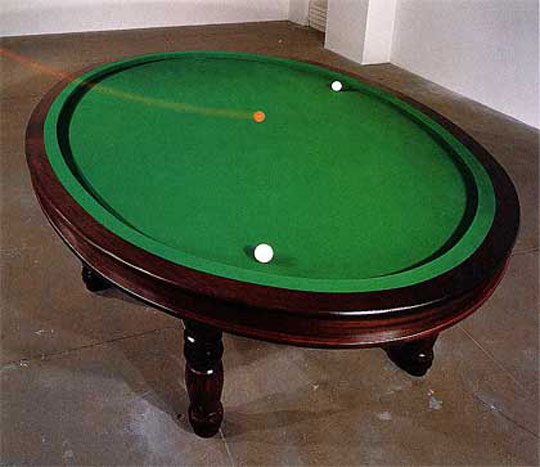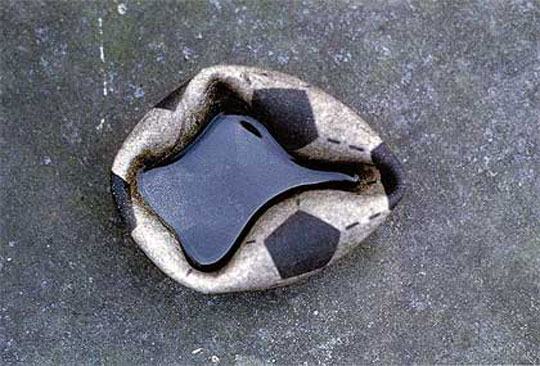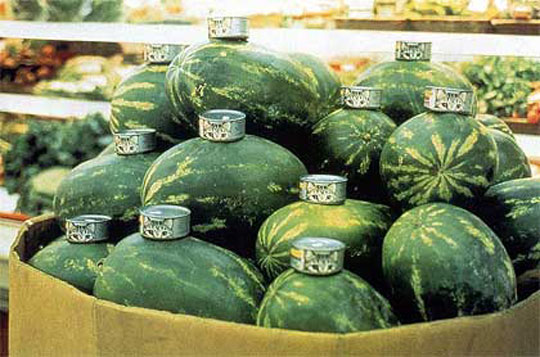Interview
Games—Ping Pong, Billiards, and Chess

Gabriel Orozco. Oval Billiard Table, 1996. Wood, slate, mixed media; 35 x 122 x 90 inches. Edition of 3. Photo by Carol Shadford. Collection MAC, galleries contemporaines des Musées de Marseille . Courtesy of the artist and Marian Goodman Gallery, New York.
Gabriel Orozco discusses his artworks that play on various types of games, and how those works relate to underlying theoretical concepts.
ART21: Ping Pond Table—where did the idea for that work come from?
OROZCO: The Ping Pond Table is connected to this idea of a new space, a new possible space. When you have a normal ping-pong game, you have a net, which is enough space between two spaces. But when you multiply that space by four, instead of two people playing, you have four people playing in four tables. You open that space so the net is also open. And what you have there is a new space because it didn’t exist before. I’m thinking in a new game, when I multiply by four the knights in the chessboard, or when I made the pendulum and the billiard table. In this case, I opened the ping-pong—the net, that space in between two spaces—I opened it up. And I have a tri-dimensional space now, in between four spaces.
That is the space that I’m interested in, the in-between space. Even in photographs, I think what is interesting is in between the photographer and the space, which is the same as the in-between of the photograph and the spectator. To activate that space—to activate means to fill it with meaning and connections, so that we can think about it. We can connect with it and make it happen as a space and time in between things.
So, in this case, it’s the net, the limit, and the border between two spaces. I opened that border, and it became tri-dimensional, a space in itself. And that’s why I decided to make the pond. I could decide to make anything I wanted. It could be a rug or sand or nothing. But then I liked the idea because the shape of the table has to be round. It’s round because you have to move; waiting for the bounce from three different tables, you have to move much more than in a normal ping-pong table.
I liked the idea of the pond and the lotus. If you want to think in a metaphorical sense, of the lotus flower as the beginning of the universe, I think you can do that because it’s a new game. It’s a new space for a new way of playing with the universe, which is this game. I think every game is a universe, in a way, or every game is an expression of how the universe works for different cultures. Ping-pong is a game about the universe playing, or is a game about how the universe is so arbitrary and how it’s constant.
ART21: Is the lotus a symbol in this work? Or is it wrong to think of it that way, of it having a specific cultural meaning?
OROZCO: It’s not that it’s wrong, it’s just that . . . Games, because they have this reference, are expressions of how we believe the universe works in different cultures. We know that chess has that, and billiards has that. Ping-pong has that, too. Every game has a connection to how we conceive nature and landscape, how we order and we structure reality. In the case of the ping-pong table, I decided to use the shape of the lotus flower and the pond and to have this reference to Buddhism or Indian culture, in terms of the lotus flower as the beginning of the universe, just because I found it interesting. I am not religious at all, but I like philosophy and science fiction, and fiction. I like these ideas in which we all try to explain with metaphors and with numbers how the universe works.
And I think it’s fascinating to know all this, but also it’s fascinating to prove it in reality, to see it in reality. You can prove and test and witness all these theories, all these fictions, all these metaphors—very, really ancient—in reality everyday. You can understand why a pond could be the beginning of the universe or the center of the universe. I think it’s quite easy to understand, if you look at a pond with so many things happening there, why it’s the origin of life. It’s just like another way of playing around with the explanation of the universe and how it works. Like in the billiard table with a pendulum, which is how planets move, how the planet Earth moves. And the same in chess. So, I think that it’s not just a game.
Probably they are more like philosophical games. I believe that philosophy has to be a practice: practical philosophy. It’s like the way the Greeks used to solve philosophical and mathematical problems—by walking. Not sitting. It’s easier to solve problems moving—when you walk and you talk—probably because you have better irrigation in the brain or just because you are breathing better. Because you are moving, you have better chances to solve complex problems. And also I think, in a way, it’s an action thing. So, I think philosophy is an action; it should be. And to play the games are part of it.

Gabriel Orozco. Pinched Ball, 1993. Cibachrome; 16 × 20 inches. Edition of 5. Courtesy of the artist and Marian Goodman Gallery, New York.
ART21: Do you ever use the word metaphysical to describe your interests?
OROZCO: I never use that word so much, metaphysical. It’s too metaphysical for me. (LAUGHS) I avoid two words: poetic and metaphysic. I avoid those two words because I think it’s a belief problem. I think the poetic happens—what we call the poetic—it happens because of the spectator, not because it is poetic. And the metaphysic is similar. So, it is an act, an act of belief or an act of illusion on the part of the spectator. For someone to say, “Yes, I’m gonna do something metaphysical,” or “Yes, I’m gonna do something poetic”—it’s a mistake. So, I think if it happens, if there is something that happens that we can call poetic, and then somebody is touched and says, “Wow, this is really poetic,” it’s because this person is open for this to happen. And the word metaphysical—I don’t really even know what it means. (LAUGHS) I believe in reality, and I don’t know what the metaphysical is. And I don’t claim that I understand what reality is.
ART21: Can you talk about the billiards table some more? How does the billiards table connect to your belief in reality?
OROZCO: I concentrate on reality in terms of what is happening to me, and I try to revolutionize that and try to rethink it and transform it. I try to transform reality with its own rules, with the things I found there. So, like the market in Brazil—I found the oranges there. Or the Island in an Island—it was a bottle with pieces of wood that was there, and I rearranged that. I never carry anything with me.
What I like about games is that a game is a thing on its own. You have a little world in this board or in this table, designed to perfection, so you can play in a landscape. When it is a good game, it’s so passionate that you can really get into this world and just live in it for a moment. When it is a good game, it’s an intelligent thing, and that’s why it’s so passionate. Billiards is very intelligent. I mean, it’s a landscape, it’s mathematics, it’s geometry, it’s physicality, it’s physics—it’s many things. My favorite is with three balls and no pockets, and you’re trying to make a triangular connection between the two other balls. I played a lot with that when I was a kid. It was more popular in Mexico than pool.
One day I was in France, and I saw the Foucault pendulum. And, as you know, it’s the way that it was proved that the Earth moves. You have this pendulum, hanging from very high, which is constantly moving because the Earth is rotating. And I found that fascinating. It’s a permanent motion sculpture; it’s a science, too. But at the same time you can consider it as beautiful as—now, okay, I don’t want to say a beautiful sculpture because I think it’s much better as an instrument for science, but anyway—I am an artist, and I look at it as a possible sculpture.
So, then I [thought], “Why don’t we transform a billiard? What happens if one of the balls in the billiard is a pendulum?” I also decided, instead of having a rectangular table, to have an elliptical table or an oval table. So then, we will play closer to laws of the universe. And then, when we put this hanging ball with the oval billiard table, which is called Oval Billiard Table with Pendulum, you can play a game, but you add complexity because now you have time involved. And you have an element, which are the elliptical bands. You cannot count on them anymore. In billiards, because it’s rectangular, you can calculate how the ball is going to bounce. And if you know a little bit about geometry, or just about billiards, you know how it’s going to bounce so you can get these triangular connections.
But in this case, because it’s an elliptical space, you are talking about the borders of the universe, and it’s always expanding. So, when the ball starts to touch the ellipses, these oval curves, it just starts to bounce around and around and then just gets lost, totally. So, you cannot count so much on the two or three times it can bounce back. It starts to just rotate around. If you were so strong that you can make this ball rotate, I mean, have the force to keep it moving, it will be just around the band of the table. On the other hand, the pendulum is moving, so you have to calculate when you hit the ball. To hit the ball that is the pendulum, you have to calculate exactly the point of connection but also the time of this pendulum coming back. So, you have to wait, and you have to breathe and see when the ball maybe is outside of the table and then comes back. And in that specific time, you have to hit it. It’s not just that it’s in a specific point in space, but it’s also in time in that point that you have to hit the ball. Anyway, it’s a totally different game, and it’s more complex in many ways.
It’s also much more boring than a normal billiard game, (LAUGHS) and also I didn’t put any rules except the basic rules of hitting two balls with your own ball. But nevertheless I think it can be interesting, and I think also what is important is that you can actually play. It’s built with everything so that you can play, and people play it. I play it sometimes, and the rules have to be invented because it’s a new system; it’s a new world and with new laws. Then you have to invent the rules. Of course, I don’t like to invent rules, but somebody will do it if they want to make some competition in that game. For the moment, it’s just a game to watch, I think, or to play and you watch. But I think it’s nice to watch because it’s a different kind of magic.

Gabriel Orozco. Cats and Watermelons, 1992. Cibachrome; 16 × 20 inches. Wendy and Robert Brandow. Courtesy of the artist and Marian Goodman Gallery, New York
ART21: Maria, your wife, said that you like to make rules for games, that you’re always inventing new games to play.
OROZCO: Well, I like to make new games. I like to improvise games in situations, and then I like the rule just because the rule makes the game grow. I like to make a game grow by trying to understand the geometry of the situation. And then you have to make some rules and times and scores and points and bounces—how many bounces and things like that. So, I like to do that. It’s quite silly but normal.
ART21: Can you talk about rules as they relate to your chessboard piece, Horses Running Endlessly?
OROZCO: Well, the knight in chess is very, very interesting. It’s fascinating because of how it moves. It moves two squares and one, but in reality it’s moving between squares. What it’s doing, that knight, is it’s jumping and it’s virtually crossing between squares to get to the other squares. That, as a notion of space, is beautiful because a board is a very bi-dimensional field, black and white. And all the other pieces—they move diagonally, up and down, et cetera. But when you conceive of the piece that is jumping between squares, it’s a very beautiful notion.
This is thinking in the game as a landscape, a micro-landscape. And you know, again, chess is a product of a culture that has a notion of nature. Those notions of nature—in terms of how it works, how it’s controlled—are expressed in the games that people invent in their time. And that civilization that invented chess—it has a very precise notion of landscape, nature, and control and production, and production of the space, and production of a country. It’s a battle, but it’s also a science.
I play a lot, and I wanted to make a chess game that was about the knight—the horse—and then I multiply it by four. They’re all horses, so there are no queens and kings, towers and bishops—just horses. And they’re running endlessly because they are all together running in this open field. You have a game that I didn’t put any rules. If you want, you can invent a game in which the horse eats another horse and then somebody wins, but it’s very boring to see horses eating each other. So, I suppose nobody is going to invent that game. How the colors in the board are placed and multiplied by four is the logic of the game itself. It’s transforming into something else, but it’s still a game.
ART21: Does this piece in any way have a reference to Marcel Duchamp, who was an expert chess player?
OROZCO: Not really. I don’t think it has a reference to Duchamp. I think it has reference to chess. It’s stronger—the reference to chess and to landscape and to my own work—in terms of playing with reality as a board; like Crazy Tourist, like Island to an Island—in terms of the scale, landscape, and the construction of reality to make it that field of perception. And I think it’s connected with reality, but reality in terms of culture.
When we speak of reality, it’s not nature. It’s not like a concrete outside. It’s always talking about cultures and specific objects. It’s not like metal is natural thing or stone is a natural thing. Stone is so charged with culture that we cannot claim that there is such a thing as a pure stone or metal or clay or water. I think, for water and all the elements, it depends on the culture they are in. They have a cultural charge, and for me to use a chessboard or a stone, it’s the same. It has the same cultural charge. It depends on the culture that you are working in. So, to claim that there is a thing, a pure thing called iron, it’s not true. Iron means a lot of things, and the artist who is using iron—he’s aware of what it means to use iron, to use marble, to use diamonds. Because those materials, they have this meaning and they have this charge. It’s the same if the material is a little bit more physically elaborate, like a chessboard. But in terms of culture and in terms of meaning, they have the same complexity and specificity.
When I’m using a chessboard as the work, I am aware of the complexity and the specificity of this game. But it’s interesting when, if I will be using stone or marble, I don’t think people will say, “Oh, he’s influenced by Michelangelo.” And when I use a chessboard, they think of Duchamp. But it’s a bit ridiculous because the marble and the chessboard—culturally, they are as complex, as charged. They have so many meanings that to claim that connection can be very superficial, at the end. If I use an orange or a billiard table, both are complex, and they are cultural, and they are social, and they have meanings. And it depends on the context and depends on my connection with that. So, I think my influence is more in connection with everyday cultural objects that I am encountering and that are part of my life.



